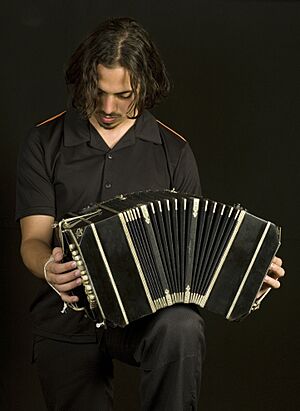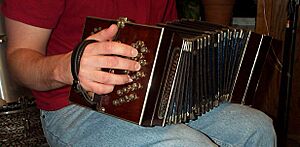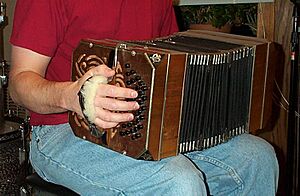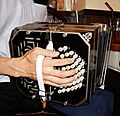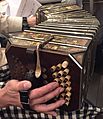Bandoneon facts for kids
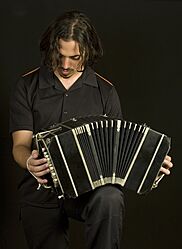 |
|
| Other instrument | |
|---|---|
| Classification |
|
| Hornbostel–Sachs classification | 412.132 (Free-reed aerophone) |
| Developed | Germany mid-1800s |
| Related instruments | |
| Chemnitzer concertina, concertina, harmonica, melodeon, reed organ, yu | |
| Musicians | |
| Ástor Piazzolla, Aníbal Troilo | |
The bandoneon (also called bandonion or Spanish: bandoneón) is a special type of concertina. It is very popular in Argentina and Uruguay. This instrument is a main part of most tango bands.
You hold the bandoneon between your hands. To play it, you push and pull its bellows. This makes air move through small metal pieces called reeds. When you press the buttons, different reeds open to make sounds. Unlike many accordions, bandoneons don't usually have switches to change their sound. But players can make it sound very emotional by changing how hard they push or pull the bellows. The left side of the bandoneon often sounds softer and more "nasal." The right side usually sounds brighter and sharper.
Contents
The Bandoneon's Story
The bandoneon got its name from a German instrument seller, Heinrich Band (1821–1860). It was first made for playing religious songs and popular tunes. This was different from its older cousin, the German concertina, which was mostly used for folk music.
Around 1870, people believe that German and Italian travelers brought the bandoneon to Argentina. There, it became a big part of the new tango style. Tango grew from an older type of music called milonga. We don't have exact records of how the bandoneon first arrived in Argentina and Uruguay. The instrument also became popular in other music styles, like Chamamé.
By 1910, German factories were making bandoneons just for Argentina and Uruguay. In 1930 alone, 25,000 bandoneons were sent to Argentina! But after a while, the instrument became less popular. Also, World War II stopped German factories from making them. This meant mass-production of bandoneons ended.
The bandoneon became a star in tango music thanks to players like Eduardo Arolas and Vicente Greco. Later, famous players like Pedro Maffia and Pedro Laurenz helped create the "sextet" tango band. This type of band often had two bandoneons. Their playing style set the standard for how bandoneons were used in a full tango orchestra, called an orquesta típica.
You can see old bandoneons in museums in Germany. One museum is the Preuss family's Bandoneon Museum in Lichtenberg. Another collection, from the Steinhart family, is now at the Tango- and Bandoneon museum in Staufen.
For a long time, bandoneons were only made in Germany. This was true even though they were super popular in Argentina. Because of this, old bandoneons became rare and expensive. They could cost around $4,000! This made it hard for new players to learn. In 2014, the National University of Lanús in Argentina decided to make its own affordable bandoneons. They hoped to sell them for much less than the old ones.
How to Play the Bandoneon
Just like other concertinas, you hold the bandoneon with your hands. When you push or pull the bellows, air goes through them. Then, when you press a button, it opens a specific reed to make a sound. The buttons move in the same direction as the bellows. This is different from an accordion, where the buttons move sideways.
Push or Pull: Different Notes!
Most bandoneons are "bisonoric." This means that one button makes a different note when you push the bellows in than when you pull them out. This is like a melodeon or harmonica.
Because of this, each side of the bandoneon has two different layouts for notes: one for pushing and one for pulling. Since the left and right hands also have different layouts, a bandoneon player has to learn four completely different ways to play notes! This is a big challenge. Many tango players mostly play when pulling the bellows. They use a special button to quickly close the bellows before pulling again.
The way the buttons are set up wasn't designed for playing simple musical scales. Instead, they were first made to help play chords easily. This was useful for singers in churches that didn't have a big organ. Over time, more buttons were added to play more notes. This made the bandoneon able to play in all musical keys.
One Note for Push or Pull
Some bandoneons are "unisonoric." This means a button plays the same note whether you push or pull the bellows. These types were made around 1925. They are more popular in Europe. But in Argentina, the traditional "rheinische" system is still the most common. This system has 142 notes and 71 keys. Most tango music was written for this traditional system.
In recent years, people have tried to make simpler bandoneons. These "hybrid bandoneons" have keyboards that are easier to learn. They still sound like traditional bandoneons. But they are designed to be easier for new players. They also make it easier to improvise music.
Famous Bandoneon Players
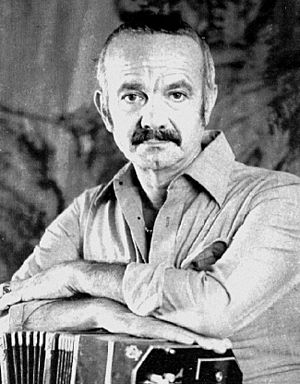
Aníbal Troilo was a very important Argentinian bandleader and composer in the 20th century. He was a master of the bandoneon. Another famous player, Ástor Piazzolla, played in Troilo's orchestra from 1939 to 1944.
Piazzolla was a composer and bandoneon player. He mixed classical music, which he studied a lot, with traditional tango. He created a new style called nuevo tango. His music, like "Fugata" from 1969, really shows off the bandoneon.
Construction
Outside the Bandoneon
Inside the Bandoneon
Instruments Similar to the Bandoneon
These instruments look a bit like bandoneons, but they are different types of squeezeboxes.
Chemnitzer concertina:
Chromatiphon:
BandoMIneDonI (This is an electric instrument with a MIDI connection):


